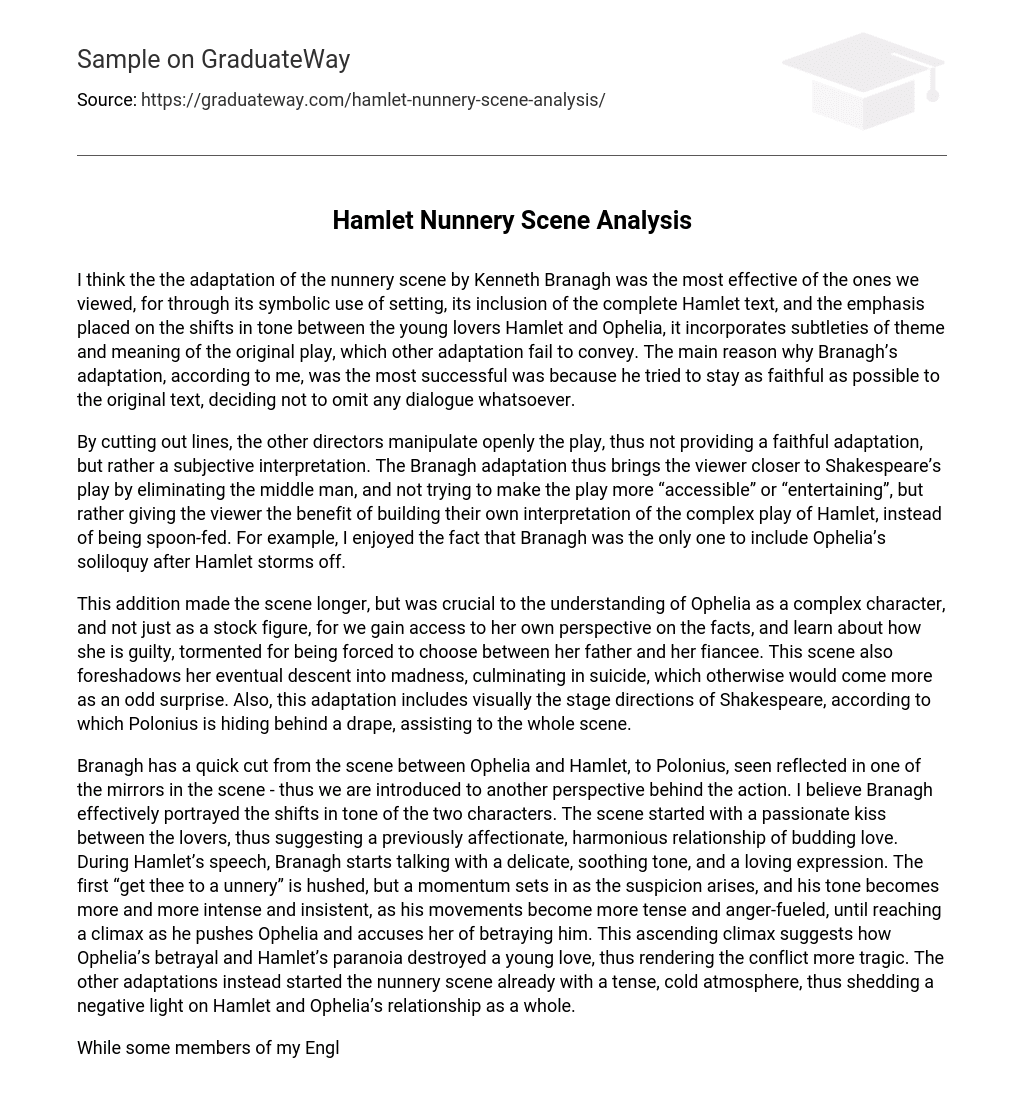I believe that Kenneth Branagh’s adaptation of the nunnery scene was the most effective out of all the ones we watched. This is because he used symbolism in the setting, included the entire text of Hamlet, and emphasized the shifts in tone between Hamlet and Ophelia, which conveyed the subtle themes and meanings of the original play that other adaptations failed to capture. In my opinion, Branagh’s adaptation succeeded primarily due to his commitment to preserving the original dialogue without omitting any lines.
The other directors openly manipulate the play by cutting out lines, resulting in a subjective interpretation instead of a faithful adaptation. In contrast, the Branagh adaptation eliminates the middle man and brings the viewer closer to Shakespeare’s play. It does not aim to make the play more “accessible” or “entertaining” but instead allows the viewer to build their own interpretation of the complex play of Hamlet. For instance, I appreciated that Branagh was the only one to include Ophelia’s soliloquy after Hamlet storms off.
This addition was crucial in understanding Ophelia as a complex character rather than just a stock figure. It allowed us to see things from her perspective and learn about the torment she experienced when forced to choose between her father and her fiancee. This scene also foreshadows her descent into madness and eventual suicide, which would otherwise come as a surprise. Additionally, this adaptation visually incorporates Shakespeare’s stage directions, such as having Polonius hide behind a drape and witness the scene.
Branagh introduces another perspective behind the action in this scene by quickly cutting from Ophelia and Hamlet to Polonius, who can be seen reflected in one of the mirrors. He effectively portrays the shifts in tone between the two characters. The scene begins with a passionate kiss between the lovers, indicating a previously affectionate and harmonious relationship. As Hamlet delivers his speech, Branagh adopts a delicate and soothing tone with a loving expression. The first instance of “get thee to a nunnery” is whispered, but the intensity and insistence in his tone increases as suspicion arises. His movements become more tense and anger-fueled, culminating in a climax as he pushes Ophelia and accuses her of betrayal. This escalating climax illustrates how Ophelia’s betrayal and Hamlet’s paranoia destroyed their young love, adding to the tragic conflict. On the other hand, other adaptations start the nunnery scene with a tense and cold atmosphere, casting a negative light on Hamlet and Ophelia’s relationship as a whole.
Despite some of my classmates in English finding the use of setting, lighting, and props to be distracting, I personally believed it to be a thoughtfully selected technique that effectively conveyed recurring themes in the play. One particularly intense moment occurs during a violent scene where Hamlet forcefully moves Ophelia through a lavish hall, pressing her against a series of mirrors and periodically opening them to ensure they are not being observed. Although not explicitly described in the script, this action-packed scene accurately captures the mounting levels of paranoia and mistrust that Hamlet is undergoing.
The play uses numerous mirrors to reflect different aspects of Hamlet and his fiancée, emphasizing the theme of identity and deceit. This theme highlights the contrast between reality and appearances. The setting is carefully constructed to portray Hamlet as a prince, captivating the audience. However, some scenes remind us that it is just a play with actors. My only criticism concerns the choice of actor for the role of Hamlet.
I believe it would have been preferable for him to choose a younger actor to play Hamlet instead of taking on the role himself. Branagh effectively portrayed Hamlet’s shifting mental state and adjusted his tone accordingly, but I found his performance unconvincing due to his age. He was not suitable in terms of both appearance and personality to portray a character in their early twenties. His lack of believability as a young man learning responsibility and maturity resulted in the crucial coming of age element being lost in this adaptation.





